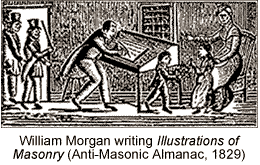The Anti-Masonic Party was the original third party to be active on the national scene. Popular opinion in America generally opposed secret organizations, but Freemasonry largely escaped this scrutiny because so many prominent citizens were members.
 Exemption from criticism ended for the Masons in 1826. In that year a bricklayer from Batavia, New York, William Morgan, disappeared. He had formerly been a Mason and was on the verge of publishing an exposé of Masonic secrets. Ties between Morgan’s disappearance and the Masons were never established, but critics use the event to turn their wrath on the fraternal organization.
The result was a rapid shrinking of the Masonic structure. In New York, membership which had been 20,000 statewide in 1826 fell to 3,000 over the next decade. The number of lodges dropped from 507 in 1826 to just 48 six years later.
Anti-Masonic fervor was especially strong in New York State, where the political machine, the Albany Regency, was run by Martin Van Buren, a Mason. Opposition was led by William H. Seward and Thurlow Weed, who attempted to stir up the democratic ire of the poorer elements of New York society. A state Anti-Masonic party was formed in 1828 and was successful with electing local and statewide candidates; the party also spread into neighboring states. In that year, Weed launched the Rochester Anti-Masonic Enquirer.
In September, 1831, the anti-Masonic Party held a national convention in Baltimore and nominated William Wirt as their presidential candidate for the following year. Wirt had been the U.S. Attorney General and, strangely, a Mason. Running against the popular Andrew Jackson, Wirt did poorly, winning only the seven electoral votes of the state of Vermont. Their prime impact had been to drain votes away from Henry Clay.
Around 1834, the Anti-Masonic Party began a rapid disintegration with some of its members helping to establish the new Whig Party and others migrating to the Democratic Party.
Exemption from criticism ended for the Masons in 1826. In that year a bricklayer from Batavia, New York, William Morgan, disappeared. He had formerly been a Mason and was on the verge of publishing an exposé of Masonic secrets. Ties between Morgan’s disappearance and the Masons were never established, but critics use the event to turn their wrath on the fraternal organization.
The result was a rapid shrinking of the Masonic structure. In New York, membership which had been 20,000 statewide in 1826 fell to 3,000 over the next decade. The number of lodges dropped from 507 in 1826 to just 48 six years later.
Anti-Masonic fervor was especially strong in New York State, where the political machine, the Albany Regency, was run by Martin Van Buren, a Mason. Opposition was led by William H. Seward and Thurlow Weed, who attempted to stir up the democratic ire of the poorer elements of New York society. A state Anti-Masonic party was formed in 1828 and was successful with electing local and statewide candidates; the party also spread into neighboring states. In that year, Weed launched the Rochester Anti-Masonic Enquirer.
In September, 1831, the anti-Masonic Party held a national convention in Baltimore and nominated William Wirt as their presidential candidate for the following year. Wirt had been the U.S. Attorney General and, strangely, a Mason. Running against the popular Andrew Jackson, Wirt did poorly, winning only the seven electoral votes of the state of Vermont. Their prime impact had been to drain votes away from Henry Clay.
Around 1834, the Anti-Masonic Party began a rapid disintegration with some of its members helping to establish the new Whig Party and others migrating to the Democratic Party.